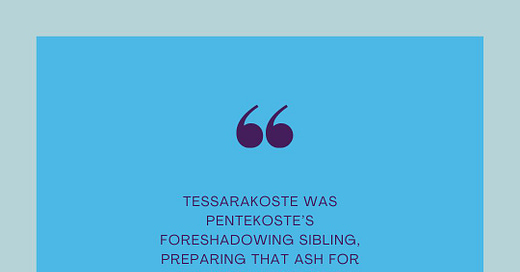Growing up in the Methodist church, I have an appreciation for the historicity and liturgy of lent. After all, the practice in relation to fasting dates back to the earliest generations of the church. The Greek word for lent is tessarakoste, a word that nods to Pentecost (Pentekoste), a connection we will touch on later, but it is important to begin by affirming the strong trinitarianism that can be derived from lent, particularly Ash Wednesday. The writings of early church fathers including Irenaeus tell us that a period of pre-easter fasting was practiced in the (two)generations that preceded him, rooting this tradition in Jesus’ own 40-day period of fasting in the wilderness (Luke 4, Matt 4:1-11).
Through medieval Christianity, the church began to clarify discrepancies such as how many days the fast should last, for example, but out of all of the counsels and creeds that took place, each one affirmed the practice.
This means that while the reformers may have disregarded Lent as largely ritualistic, it actually has deep ancient roots in our faith. Keeping in mind that the fathers of our faith are the early church fathers and not the founding fathers of America (who were largely deists, rejecting orthodox trinitarian theology all together) nor the fathers of the reformation, it is essential that we make space for ancient mystery as the postmodern church seeks to rekindle some of what was lost in modernity’s “enlightenment”.
But I think that while Ash Wednesday serves to invite us towards repentance, it also invites us into a posture of reverent worship. And I also think that a greater appreciation for the larger Christian tradition that evangelicalism is a part of, is a much-needed perspective to understand this better.
Symbolically, it is in the ash that our willingness to choose rescue meets the willingness of the grace of God to traverse heaven and earth in God’s own unique and paradoxical way of delivering his people- through the participation of belief.
Through the incarnation, Christ relinquished all power and became like us in every way, in order to save his creation from sin, through sacrificial love. Just as cosmic goodness collided with dust in creation (Gen 1:10), it does so too in resurrection, redemption and restoration in Jesus. This collision is worship, through and through. And when the holy flame of the Spirit combines divine breath with dust, the result is a sweet aroma of praise to the Father (of acts 2). The ash is therefor a byproduct of our offering, that points to resurrection hope. What the world might count as a lost cause- mere dust- the Lord has charged with his holy fire.
Sonderegger points out that In Jesus, God not only becomes the atoning sacrifice, in his becoming he joins us (as we join one another) in a worshipful aroma of offering and praise that images the perichoretic nature of the divine. In Christ our ashes are consummated in hypostatic union, destined for resurrection. Ash doesn’t exist without fire. And dust created “ex nihilo” doesn’t exist without a purpose from its maker. This means the very nature of the ashes signify our dependency on our maker therefor our offering is nothing without both God’s blessing and partnership. And if Jesus is simultaneously (mysteriously wondrously!) the sacrifice, the atonement, the offering, and the object of our worship- then the ashes do not signify death, but the coming of new life!
Because of the holy self-giving love of God in action, we too may become like him, with him, with one another.
This is what it means to live as the temple of the living God.
This is what it means to live as if death and sin don’t get the last word.
The concept of ash as an illustration is contextualized by consecration. Something had to be set apart, for the purpose of making it holy, as worship- just as Christ set apart himself.
So, the question of lent is not what are we giving up, but who are we giving ourselves to? What is that giving like?
Similarly, if our individual bodies and the ecumenical church as one body are living temple(s) indwelled by the Holy Spirit (Ephesians 2:18-21), a living sacrifice (Romans 12:1), then what sacrifice are we?
If ashes are the byproduct of worshipful sacrifice, then who are we sacrificing to and what for?
If our ashes empowered by the fire of God to burn like a sacrificial offering of worship, what is that worship like? is it individualized? privatized?
or is that sacrificial offering relational in nature?
Is the Lenten worship that we should be pursuing reconciliatory, just and righteous in nature?
Repentance is always an invitation to grow closer to God in communion with the saints and worshipful intimacy. So, what is that God like?
That God is like Jesus, because that God is Jesus, and like Brian Zahnd always says, Jesus is what God has to say about himself.
It is no surprise then that to the early church, Tessarakoste was Pentekoste’s foreshadowing sibling, preparing that ash for the arrival of both resurrection and anointing by the coming of the holy spirit, to the glory of the Father. May we also seek to worship, as we draw near to God and one another in humility and reverence.





